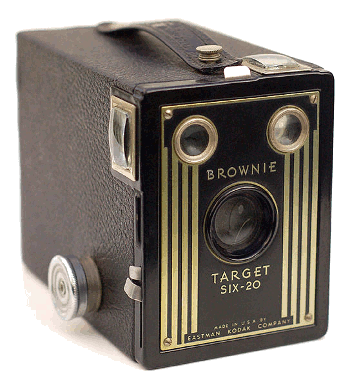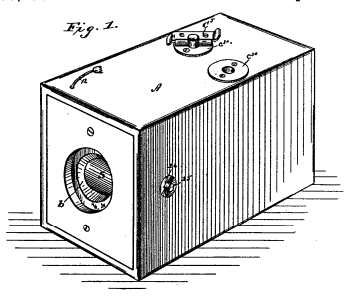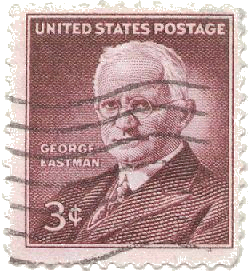George Eastman and Kodak
February 21, 2012
My wife has a
Kodak EasyShare C875 camera, a gift from her students many years ago. It was her first
digital camera, it still takes excellent
photographs, and it works with our
Linux operating system computers using
gThumb. I presently use this camera more than she, and some images on this web site were taken with that camera.
Eastman Kodak, which has been a
photography company since 1889, announced its departure from the camera business on February 9, 2012, about a month after filing a
Chapter 11 reorganization to avoid
liquidation.[1-2] Kodak's problem, as my colleagues and I discussed more than a decade ago, was that it was a
chemical company, and photography was transforming from a
chemical process to
consumer electronics. The
electronics companies had an advantage that Kodak could not overcome.

Kodak Brownie Camera.
My parents owned one of these. Various Brownie models were sold in the 1940s and 1050s. Some of my baby pictures were taken with one of these.
How quickly they grow!
(Photograph by John Kratz, via Wikimedia Commons)
Photography was
invented in 1826 by the
Frenchman,
Nicéphore Niépce, whose process was more akin to
photolithography than
silver-halide photography as practiced in the
twentieth century. In his process, a
pewter plate was coated with a
bitumen material which hardened through exposure to
light.
When the unexposed bitumen was washed away with
solvents, what remained were the light pewter regions protected by the bitumen, and the bare,
tarnished regions, thus rendering a positive image. Niépce also experimented with
silver nitrate, which was known to darken upon light exposure.
The turning point that brought photography to the masses was
George Eastman's 1884 invention of a
roll film that would adequately replace
photographic plates. Eastman had significant experience with photographic plates prior to his roll film invention. As for the name, Kodak, it's been explained that Eastman liked the sound of the letter,
K. He experimented with words that included
K, and found one that began and ended with a
K.

Figure 1 of US Patent No. 388,850, by George Eastman, September 4, 1888.
(via Google Patents). [4)]
George Eastman was born on July 12, 1854, in
Waterville, New York, which is a very short distance from my childhood home of
Utica, New York. When you travel on State Route 12, south from Utica through Waterville, you'll see a roadside marker that identifies Waterville as his birthplace.
For those of us who are accustomed to
plastic film negatives, usually made of
cellulose acetate or
polyester, it's surprising to learn that Eastman's original
photographic film was an
emulsion on a
paper roll. The emulsion was transferred to a
glass plate as a step in the
printing process.
Of course, most of us are familiar with the infamous
celluloid (
nitrocellulose), a plastic used in early
motion picture reels, much to the detriment of
archivists. Surprisingly, celluloid remained the
film stock of choice for motion pictures well into the twentieth century, although Kodak introduced
cellulose acetate film stock in 1908. Cellulose acetate was also known as "safety film," for obvious reasons.

An example of irony.
The master of photography rendered in an etching.
George Eastman on a 1954 US Postage Stamp.
(Via Wikimedia Commons))
Unlike many of his contemporaries, who were often called
robber barons, Eastman was very charitable. His
philanthropic bent may have been a consequence of his humble beginnings. He donated many millions, sometimes anonymously, to various charities and universities, including two
historically black colleges. He donated large sums to the
University of Rochester and the
Rochester Institute of Technology in his base of operations,
Rochester, New York; and also to the
Massachusetts Institute of Technology.
The company, Eastman Kodak, had an amazing 133 year existence. However, the
technology of the
Wright Brothers biplane does not compete in today's
jetliner world; likewise, Kodak's chemical process has been overtaken by better digital technologies. Not only that, but these technologies are so inexpensive that digital camera are added as an accessory to all
mobile computers and
cellphones.
Kodak has promised to honor
product warranties and continue technical support for its legacy products.[1] Kodak does have a hefty
portfolio of patents on digital image capture that's generated three billion dollars in
licensing revenue since 2003, and it's presently suing
Samsung,
HTC and
Apple over alleged
infringement of its patents.[2]
Industry observers think that Kodak may be an attractive
takeover target because of this intellectual property.[2]
Google, which is seeking to acquire
Motorola Mobility in part because of its mobile phone patent portfolio,[5] may become interested in Kodak. I think the acquisition price will be fair, because there will likely be more than one suitor.
References:
- Kodak exits digital camera market, BBC News, February 9, 2012.
- Eastman Kodak files for bankruptcy protection, BBC News, January 19, 2012.
- George Eastman, "Photographic Film," US Patent No. 306,470, October 14, 1884.
- George Eastman, "Camera," US Patent No. 388,850, September 4, 1888.
- Trefis Team, "Google's Motorola Mobility Deal Gets Green Light from U.S. and Europe," Forbes, February 14, 2012.
- History of Photography Page on Wikipedia.
Permanent Link to this article
Linked Keywords: Kodak EasyShare C875 camera; digital camera; photograph; Linux operating system; computer; gThumb; Eastman Kodak; photography; Chapter 11 reorganization; liquidation; chemical company; chemical process; consumer electronics; electronics company; Kodak Brownie Camera; John Kratz; Wikimedia Commons; invention; Frenchman; Nicéphore Niépce; photolithography; silver-halide; twentieth century; pewter; Bitumen of Judea; bitumen material; light; solvent; tarnish; silver nitrate; George Eastman; roll film; photographic plate; Google Patents; Waterville, New York; Utica, New York; plastic film negative; cellulose acetate; polyester; photographic film; emulsion; paper; glass; printing; celluloid; nitrocellulose; motion picture reel; archivist; film stock; cellulose acetate film stock; robber baron; philanthropic; historically black colleges; University of Rochester; Rochester Institute of Technology; Rochester, New York; Massachusetts Institute of Technology; technology; Wright Brothers; biplane; jetliner; mobile computer; cellphone; product warranty; portfolio of patents; licensing; Samsung; HTC; Apple; infringement; takeover target; Google; Motorola Mobility.